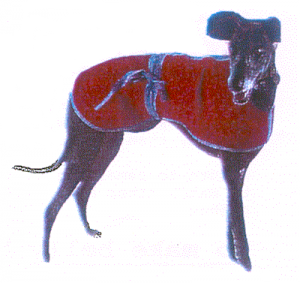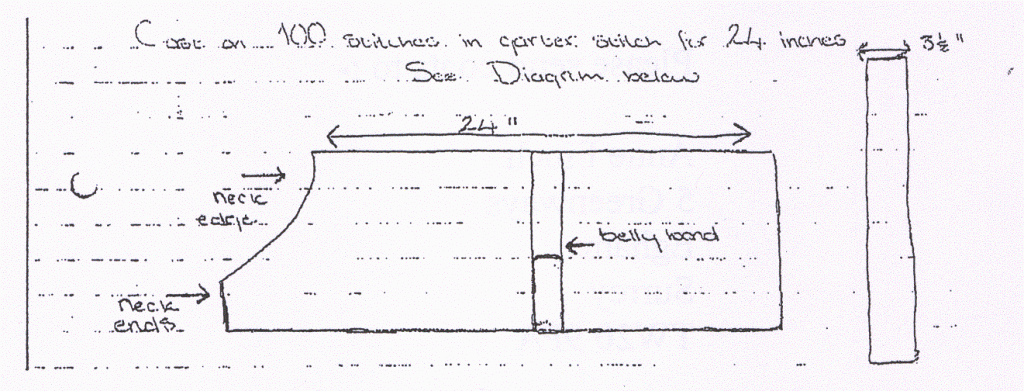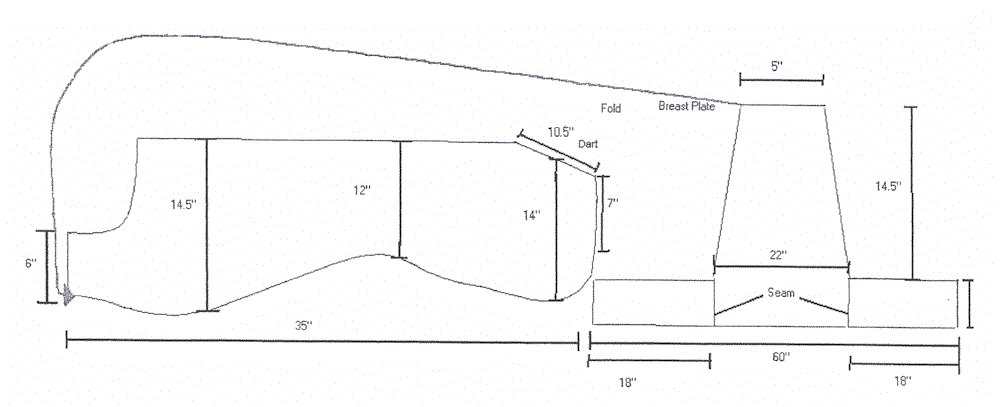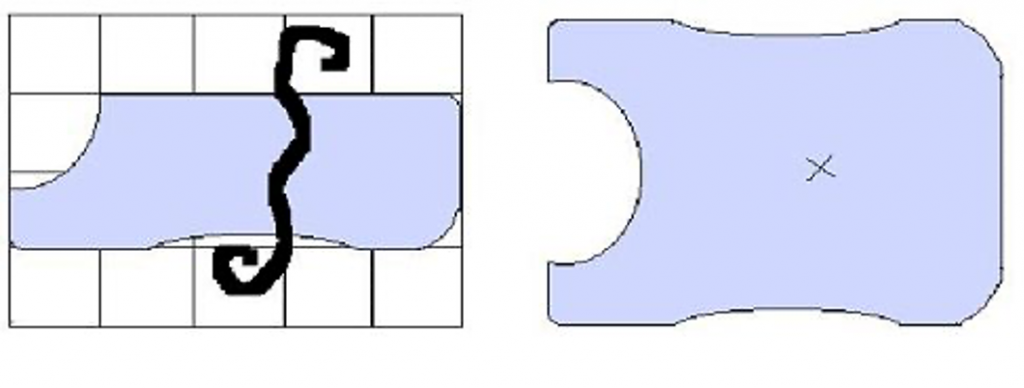Make a coat for a cold Rescue Greyhound

sewn coat illustration
Could you make one of these simple dog coats? Make one for your own dog, or better yet, make several and send some to GIN.
Inland Spain suffers from extreme seasonal weather variations, so in the winter it gets bitterly cold. The constant flow of dogs through our hands all need coats.
- Knitted coat pattern
- Sewn coat pattern
- Sewn “snuggler” coat pattern (dog nightie!)
Knitted coat pattern
Charity shops sometimes sell “odds and sods” of wool cheaply that may be suitable. They may also be able to sell you very cheaply mens neck ties that are too grotty to put on

sewn coat pattern
display; 2 of these with the thin ends sewn to the make coat as in step 9) make good alternative belly bands.
- Size 8 or 4mm needles
- 500g ball of Arran wool or suitable thick wool.
1) Cast on 100 stitches in garter stitch and knit for 24 inches.
Divide neck as follows:
2) With right side facing, knit 43 stitches then cast off 14 stitches which will be centre of the neck.
3) Knit the remaining 43 stitches from the left hand needle onto the right hand needle.
Shape neck as follows:
4) Starting at beginning of row knit 43 stitches then slip remaining 43 stitches onto stitch holder.
5) Starting at neck edge decrease one stitch every alternate row (by knitting two stitches together) until 20 stitches remain, then cast off.
6) Return to remaining 43 stitches on stitch holder and repeat to match other side. Wrong side facing, sew neck ends together.
To make belly band:
7) Cast on 1.5 inches in garter stitch.
8) Knit for 66 inches and cast off.
9) Sew band onto dog coat half way down. (To tie under belly)

knitted coat pattern
Sewn coat pattern
An old blanket is fine. Fleece is perfect if you have it. Think warm!
Charity shops may be able to sell you very cheaply mens neck ties that are too grotty to put on display; 2 of these with the thin ends sewn to the make coat back as in step 6) make good alternative belly bands.
- 1 yd fabric
- bias binding
- Transfer the sewn coat pattern (right) onto a newspaper. Each square of the grid represents 6″.
- Fold the material that you are going to use, pin the template on and cut out.
- Sew the dart for the hips.
- Use bias binding to bring neck edge and sides. If you don’t have any binding then use zig-zag on the raw edges.
- Sew the front neck edges together.
- Attach a six foot band midway on the back for the belly binder.
Yes, the belly band does need to be six foot long. It’s attached on the back of the coat, the 2 ends pass under the dog’s tummy up the other side and tie on his back. It save’s a lot of wear and tear on helper’s backs if they don’t have to delve under dogs tums!
Sewn “snuggler” coat pattern
This is a pattern for a snuggler coat. It is experimental and works well in the thermal fleece material which fits cosily and draws up over the dog. I’m not sure how it works with blanket material but if you have a dog at hand to experiment with, maybe you can adapt it to suit the material that you can get hold of cheaply. The advantage of it is that there is not the danger of narrow ties cutting the dog under the belly and also there is the added warmth of the breast plate over the tummy.

MAKING A COAT FOR A SHIVERING SKINNY! – an alternative pattern
Using the template below as a pattern (each square on the grid is 6″ (15 cm) sq.), present the top edge of the template to a fold in your material and cut it out double. Do this twice, and with right sides together, sew all round the outside edges leaving a small gap to be able to turn the whole thing inside out. Sew a six foot band of soft material at least two inches wide onto the middle of the back for the belly band. Finally, oversew or bind the two thick edges which go over the breastbone very firmly together. This can be a weak spot.
Standard blanket/coat material can be used double unless it is particularly thick and could do singly, perhaps with a flannelette/soft cotton lining. Another idea is to cut up and use material from second-hand padded anoraks (which have the advantage of being waterproof) or padded dressing gown material.

 .
.